 4
4

Examining the pyramid with the mions
 19. 04. 2024
19. 04. 2024



 4
4

 19. 04. 2024
19. 04. 2024

 1
1

 17. 04. 2024
17. 04. 2024
 6
6

 16. 04. 2024
16. 04. 2024
 03. 01. 2020
03. 01. 2020

A new genetic study performed on 1739 individuals from 219 Asian populations found that DNA of denisans on the Indian subcontinent is predominantly among isolated strains. It was also found that there are far fewer denominated ancestors among the people of India and Pakistan of purely Indo-European descent. But these findings mean much more for the possible presence of ancient Deniseans in South Asia, who may have been recorded in Indian mythology as bloodthirsty demons called rakshasas.
The study, led by American and Asian scientists from Nanyang Technological University in Singapore, the National Institute of Biomedical Genomics (NIBG) in Kalyan, India, and the University of California, USA, was conducted primarily to correct what tends to neglect Asians in genetic research. Its conclusions will have implications for our understanding of the formation of populations in Asia and for medicine and health in this area.
According to Parth P. Majumder, co-founder of NIBG and one of the co-authors of a new article published in Nature, this study is so far the largest in terms of Asian DNA and comes in response to the earlier absence of Asian genome data. Moreover, the importance of this study is emphasized by the fact that at present genome data is obtained from DNA chips - microchips that are equipped with half-double-helix DNA probes capable of recognizing DNA from test samples. These are normally optimized for the europoid population. Thus, they can provide inaccurate data on the Asian genome, which is noticeably different.
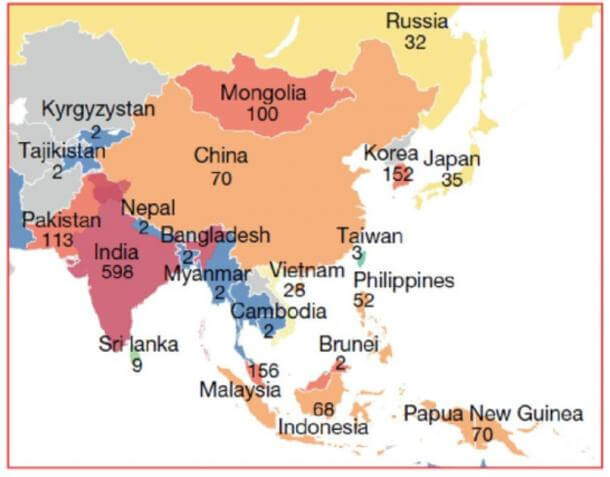
Objectives of the study - non-European languages
Majumder explained that the aim of the study - which represents the pilot phase of the GenomeAsia 100K project - was to generate and catalog DNA sequences and variations on a large sample of Asian population. In addition, it was to determine if any conclusions could be drawn from the entire gene sequence databases, and that medical data could be obtained from these data.
Majumder explained that these new data are important for the detection of genes associated with diseases common among Asian populations. Proteins are also important because changes in proteins are related to disease. For example, a variant of the gene (NEUROD1), which is associated with a specific type of diabetes, was found to be present in DNA among the Asian population tested. Another variant of DNA in the hemoglobin gene associated with beta-thalassemia is found only in people from southern India. Most notably, the discovery that carbamazepine, an anticonvulsant used to treat health problems, could have serious side effects for the 400 million people in Southeast Asia who are part of the Australian language group. In addition to finding new knowledge about the genes associated with diseases typical of Asian populations, the study also focused on the genetic basis behind the origin, cultural spread, and geographical location of these populations, with an emphasis on those living in the Indian subcontinent.
Majumder and his team found that indigenous tribes and populations speaking non-European languages carried the highest amount of DNA denisans, adding that this is less evident in the "upper" social caste. The people speaking Indo-European languages, especially the people of Pakistan, had the lowest content of the Denisovan component of all groups. These results were obtained by correlating the amount of DNA denoted with the language spoken by the individual, as well as his social and caste status. In addition, the Denisan origin of Indo-European languages has been compared to those who spoke non-European languages, such as the Dravidian language group spoken by more than 215 million people, mostly in southern India and northern Sri Lanka.
The team found that the average proportion of Denisan genetic heritage was significantly different between the four social or cultural groups, in line with the fact that the Indo-European-speaking populations believed to have arrived in the Indian subcontinent from the northwest mixed with native South Asian groups, or groups that not only carried a higher proportion of Denisan genes, but also spoke non-European languages. Furthermore, the study compared the genetic markers of Denisan origin found in indigenous populations of the Indian subcontinent with those of Denisan, divided into Siberian denisans - characterized by the genome of fossil remains of the Denis Cave in Siberia and current populations living, for example, in China. It is considered that they inhabited the former Sundian mainland, which until the last ice age connected today's Malaysian Peninsula and the islands of Indonesia.
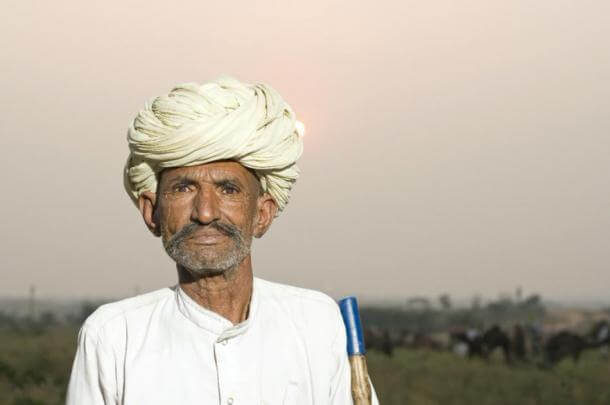
Majumder and his team found that the genetic heritage of the Denisans present in the indigenous population of the Indian subcontinent belong to the Denish Dennis, not to their northern relatives, who lived probably in the Siberia, Mongolia and Tibetan Plateau, and East Asia, especially northern China.
The proportion of Denisa DNA in South Asian populations was consistent with that found in the Melanesians of Papua New Guinea and Aeta, a Negrite tribe from the island of Luzon in the Philippines, although the proportion of Denisa's genetic heritage was significantly higher. This led the authors of the study to conclude that the mixing of Sunda Denisians and anatomically modern people who arrived in the area must have taken place somewhere near the former Sunda mainland, where the gene trace of Denisans remains strongest. Because the same DNA of Denisans is found among the indigenous peoples of the Indian subcontinent, Majumder and his team believe that after this mixing, modern humans, already carrying Denisian genes, traveled west to Southeast Asia and entered South Asia, where they settled, which explains the high the ratio of Denisovan DNA recorded in the pre-Indo-European population of the Indian subcontinent.
Majumder and his team also stressed the fact that the Aets, besides the high proportion of Denisan gene heritage between the Melanesians and the Aets, consistent with the ongoing blending common to these groups and South Asians, also carry a mitochondrial haplogroup of Denisans unique to this population. . This suggests that the second mixing between the Aets and the Denisans had to take place after the separation of the Aets and Melanasians, perhaps recently, 20 years ago. Indications of this second blend with the denisans and indigenous people of Indonesia and the Philippines were found earlier in another study whose results were announced earlier this year. At that time, it led to the theory that there were not only two basic types of denisans - Siberian and Sundanese, but also a friction type that most likely separated from the Sundanese denisovans.
For our understanding of the mix between the denisans and the modern man, and at the same time when and where it happened, this information is very favorable. This means that the assumption by Majumder's team that the main cause of the high proportion of Denisan DNA in South Asians is the migration of a modern man who encountered denisovans on the Sundian land and carried Denisovan genes with him to the west may be only half the story.
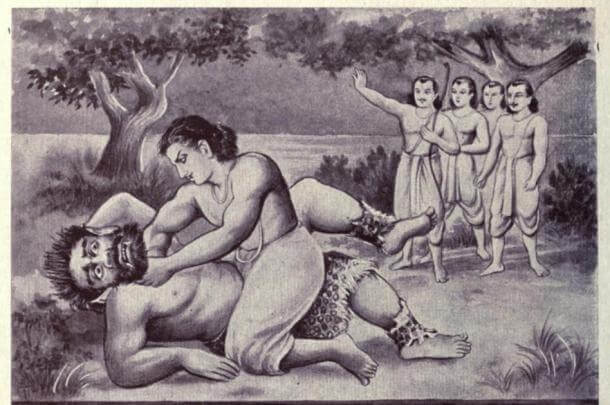
Rakshasas
If that is the case, why the negrite population in the Andaman Islands in the Bay of Bengal, which shares genetic traits similar to the Aetas of the Philippines, bears no traces of Denisan genetic heritage. Indeed, if the ancestors of Aetian negrites from the Philippines carrying Denisan DNA or the Melanasians of Papua New Guinea migrated westward, they would leave traces of their presence among the original negrite tribes inhabiting, for example, the Andaman Islands, but that is not the case. There is no DNA of denisans among the Andaman islands. The counter-argument could, of course, be that the half-breed between modern people and the Denisans of Southeast Asia migrated across the country, thus completely avoiding the Andaman Islands.
Another, and in my opinion more likely, scenario explaining the presence of Denisan DNA among South Asian indigenous people is that our oldest ancestors, modern-type people, migrated from Africa over the Arabian Peninsula 60-70 years ago and subsequently penetrated into South Asia via Pakistan.
Here, or perhaps even deeper in the Indian subcontinent, apparently in India itself, they met with the Denish Dennis who had lived in this area for decades or perhaps hundreds of thousands of years. There was mixing. These half-breeds, now carrying the DNA of the Denisans, continued their journey east to Southeast Asia, where they met more and more Denisans and crossed with them. Eventually they reached the edge of the Eurasian mainland. Here they became the oldest ancestors, among others, residents of the Sunda mainland, and at the same time Aetas and Filipinos and Melanesans from Papua New Guinea, which was then part of a huge island continent called Sahul, whose southern part was Australia. When this happened, it is open to speculation, but undoubtedly it did not occur later than 45-60 thousand years ago, with further migration waves continuing up to 20 thousand years before the present.
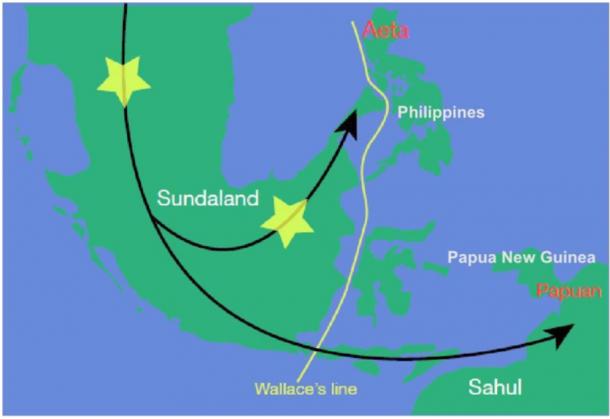
Second mixing
Again, this theory has minor shortcomings, with the lack of Denisan DNA among the Andaman people being just one of them, but this alternative scenario not only makes sense, but also points to the presence of the Sundanese Denisans in the Indian subcontinent, with their predicted greater height, allegedly, from the perspective of a modern man, a grotesque appearance, and perhaps their disgusting eating habits, probably caused them to be portrayed as rashshas in mythology. They were demonic beings, often mistaken for asuras, created according to Vedic literary narration at the end of Satya Yuga from the breath of the sleeping Brahmā. Satya Yuga was the first of a cycle of four yugas to last 1 years (currently we are at the end of the fourth and last cycle known as Kali Yuga, followed by a new Satya Yuga).
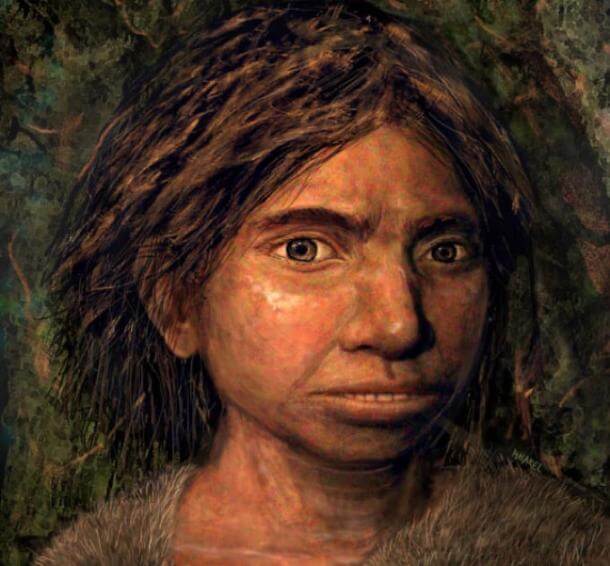
Second mixing
It is said that as soon as the Rakshasas were created, they were so absorbed in their bloodthirstyness that they began to devour Brahmā himself! He shouted "Rakshama!" (Sanskrit "Protect Me!"), And then came the god Vishnu, who rushed to help Brahmā and drove all the rakshasas, who have since been derived from Brahmā's call for help, to the earth.
Although the Rakshasas are a product of exuberant imagination, their presence in the world before the arrival of the first human dynasties suggests that they are a memory, albeit highly distorted, of a group of archaic people who once inhabited the Indian subcontinent. If so, it would mean that the most likely real counterparts of the Rakshasas were the denisians who lived for hundreds of thousands of years the eastern half of the Eurasian subcontinent and whose last living representatives 20 years ago apparently met indigenous people such as Aety of the Philippines.
By: Andrew Collins